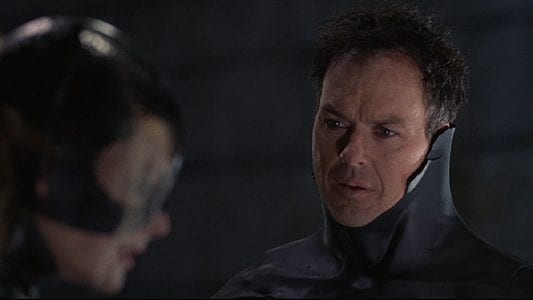Sequels rarely live up to their predecessors, much less surpass them. Tim Burton’s Batman Returns is exactly that sort of rare gem, plucked from Warner Brothers and DC Comics eclectic chest of Batman cinematic offerings.
I’ve argued before that Batman Returns is my favorite unconventional holiday film due to its being set in snow-covered Gotham City where the heroes and villains wear their childhood traumas as well as they don their respective masks, but there’s more to it than that. This is one of Burton’s finest hours before his aesthetic became (somewhat) conventional and Disney finally saw dollar signs for films like Charlie and the Chocolate Factory and Alice in Wonderland.
Every angle of Batman Returns is art deco-tinged anguish. Gotham City is still dark and dangerous as ever, but no one seems to be able to leave the concrete jungle, and new villains reign below in the sewers (with Danny Devito’s repulsive Penguin) and wreak havoc in highest skyscrapers in the form of Christopher Walken’s millionaire Max Shreck.
Michael Keaton’s Bruce Wayne/Batman is still tortured and sullen, cleaning up the streets as a coping mechanism after seeing his parents killed before his very eyes. There’s also Selina Kyle, an undervalued secretary turned Catwoman hath no fury, played with dazzling fierceness by Michelle Pfeiffer. Burton actually went on record a few years ago saying Pfeiffer’s turn as Catwoman was his favorite performance in any of his films, and with good reason. Every time she’s on-screen, she’s breathtaking and damn near breathless (from being vacuum-sealed into the catsuit for take after take).
Burton’s first Batman flick is a straightforward origin story for both its hero and villain. In Batman Returns, it feels like every character has an ax to grind or demon to dispel. In the Penguin’s case, his rich parents dumped him at the zoo one winter night and he’s worked his way back up the surface with one goal in mind: making all the other first-born sons of Gotham pay for his abandonment. Danny Elfman’s magnificent score adds music box and lullaby touches to play up the lost childhood elements in the Penguin’s backstory.

For Catwoman, it’s never being heard or appreciated–and then getting in trouble when Shrek finds out she knows what he’s up to with his powerplant project. (“Who knew she had a brain to damage? Next time I’ll throw her out of a higher window,” he laments in the way only Christopher Walken can.) Pre-transformation, Selina lives in a Pink Ladies-worthy apartment with an answering machine full of terrible voicemails from her overbearing mother and non-committal ex’s.
Later on, when her a Bruce Wayne verbally spar on their fire-side date, she drops a searing line when it’s apparent Bruce is scared he’ll come off as unhinged: “It’s the so-called normal guys who always let you down. Sickos never scare me. At least they’re committed.” Heathers screenwriter Daniel Waters’ biting dialogue is iconic and timeless and also serves as both a sweeping verbal twist and reprise that will gut the lovely foes down the line.
Until then, Catwoman is ready to right the wrongs against womankind and proves herself a slinky adversary for both Batman and Penguin, playing both sides against the middle. As she says:
“Life’s a bitch, now so am I.”
The Masks They Slide
Maybe Burton’s Batman films imprinted on my brain at an early age–I saw Batman on HBO and then twisted my mother’s arm to see Batman Returns in the theater even though I wasn’t old enough yet–but all the efforts after this film feel emotionally lacking. Yes, Batman is built. Yes, he has anger.
But what about pathos? I’m not sure anyone could have competed against Heath Ledger’s own indelible take on the Joker, so Christian Bale had to settle to be the straight man in a bat suit. Michael Keaton’s Bruce Wayne feels like a loose cannon, with touches of gunpowder planted just under the skin, ready to blow at any second. This only amplifies when he meets the emotional powder keg that is Selina Kyle.
While the Penguin is a lost cause, Selina isn’t. Sure, she smashes up her apartment and patchworks together a new persona after a lifetime of #metoo moments, but she’s also the girl asking herself “Why are you doing this?” outside a department store window.
Bruce asks her the same once both their metaphorical and physical masks have slipped. Only hours prior, in the subtlest, most heart-wrenching moment, they are the two people who show up to a costume party with no need for masks. It’s then that she parrots back a line they spoke to each other when they were playing heroes and villains upon the rooftops of Gotham:
“Mistletoe can be deadly if you eat it…a kiss can be even deadlier if you mean it.”
Bruce wipes Selina’s tear-stained face and the two hold on to each other she asks the question for the ages: “Does this mean we have to start fighting?”

In Bruce’s mind, the answer is no, and once the Penguin’s plans of destruction sink, his intentions turn to her. My inner 11-year-old will never get over the moment Bruce decides to discard his bat mask, the rubber cowl jaggedly tearing. It shocked me then, and it rips my heart every time I watch it now as an adult. (Star crossed lovers are my favorite flavor.)
“Bruce, I would, I would love to live with you in your castle… forever, just like in a fairy tale. I just couldn’t live with myself! So, don’t pretend this is a happy ending!”
She’s not wrong. Early in the film, when she punctures Batman in a fight, Bruce Wayne just pulls another bat-suit from the vault. Selina’s catsuit is frayed to the point that she appears physically feral, matching her emotional state. They might seem the same, but they come from very different worlds. Her taste for revenge and doing away with Shreck sadly wins out in the end, leaving Bruce alone to dwell on what could have been.
You’ll Never Know
The film ends on a cliffhanger that never came to pass, with Catwoman watching the bat signal from a distance. It also marked the beginning of the end of Burton’s association with the Batman franchise as a whole. Audiences were torn on whether the sequel was too light or too dark, and Michael Keaton decided to step away for good.
Burton went on to produce the Mardi Gras kaleidoscope of a film that is Batman Forever, and there the franchise spiraled far away from the dark and poetic landscape he’d been able to build and back towards the camp of the Adam West series. Various actors donned the bat suit less for art and more for money (I’m looking at you, George Clooney) and then Gotham was simply a grey-toned Chicago in Nolan’s gritty and modern trilogy.
I’ll always wish we’d gotten more Burton-directed Batman, the same way I wish we could have seen his deserted take on Superman but in the end, we got the best Batman film, crackling with character-driven performances, forever encased in a gothic snowglobe world. I’ll let Siouxsie and the Banshees show us out.



Perfectly written and I feel exactly the same. Batman Returns was much better than the first because Burton was given more freedom to full portray his version of Batman. I also find the writing in this one so much more emotionally driven. That last scene where he takes off his mask and says they’re the same, split right down the middle gets me every time and I feel like this movie perfectly captured their connection. They just had this deeper understanding of each other that isn’t explored as well in The Dark Knight Rises. I’m so disappointed Burton never got to make his third Batman movie and I’m so curious how he would have ended it with Selina and Bruce. Perhaps we will see Michelle Pfeiffer again in the role now that Michael Keaton is signed on to reprise Batman in a new Flash movie. I also watch Batman Returns every year around Christmas time.
Ryan – thanks for your thoughtful comment. I’m glad you enjoyed this – and let me know how you feel after you revisit. I’m around that age, for sure. I remember shopping at the mall and my mother asking a Claire’s associate if it would be okay to take me to the movie (it was PG-13, after all) and the associate said there wasn’t anything too scandalous, and somehow that convinced my mother to take me. And I had all the happy meal toys, too!
Awesome write up. Thanks for that! We must be around the same age (39). Like you, I watched the first Batman on HBO several times and liked it for the most part. When Batman Returns came out I went crazy for it. I still remember unwrapping the VHS tape for Christmas. And like you, I always associate the film with Christmas because of the holiday setting.
The negative for me is that I had a hard time following the plot as a child. It always felt Like the toys locked up behind the window of the toy store for me. It looked so good, and I wanted so much to be a part of that world and to play with it, but in the end I couldn’t hang with it and lost interest.
I watched it as an adult years ago, but I don’t remember it too well, maybe I should give it another shot. As I’m typing this I’m remembering the McDonalds happy meals with Batman Returns figurines. Funny the things we remember all these years later.
I enjoy reading your write ups.